Survey Results
Each quarter SWPP surveys the workforce planning community on critical workforce planning topics. Over 160 call center professionals representing a wide variety of industries participated and provided insight into this quarter’s survey on forecasting processes.
Survey Participants
Fifty-six percent of the 160+ respondents in this survey work in centers with over 500 agents. The rest are representative of a wide variety of sizes from under 50 up to 500 agents. The financial, heath care, and insurance industries drew the largest number of participants, but all other industries are also well represented.
Forecasting Utilization
Respondents were asked if they forecast to determine staffing requirements. Two-thirds indicated that they do use the forecast to drive staffing levels. Only 2 percent indicated that their staffing numbers are constant, so forecasting does not matter. The remaining 31 percent do forecast, but the forecast does not completely drive the staffing levels.
In some cases, the budget is a major determining factor in staffing with the forecasting used primarily to determine how to best utilize the staff available. Only at the time that budgeting is negotiated would the forecast play a major role in staffing models.
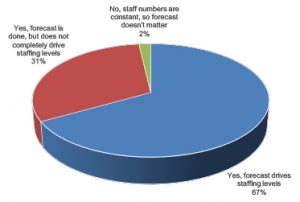
Who Performs the Forecast
When asked who is responsible for producing the forecast, 61 percent indicated that there is a dedicated forecasting specialist. Given that over half of the respondents are in centers with over 500 agents, that seems logical as the WFM team is likely to have several members. Only 2 percent indicated that the forecast comes from someone outside of the WFM team. The remaining 37 percent have a WFM generalist who does the forecasting along with other tasks such as scheduling.
In general, the skill set for a forecaster includes strong math knowledge and ability to communicate with those who influence the workload to be successful. Schedulers are typically puzzle solvers and strong communicators with the agent staff. As a result, as the WFM team grows, it is common to see some staff gravitate toward the forecasting tasks and others to the scheduling.

How Forecasting is Accomplished
The respondents were asked how the forecasting is accomplished. Respondents were offered the option to choose more than one method and nearly all who chose the WFM software also chose spreadsheets. As noted in the comments at the end of this report, there is a lack of willingness to rely on the forecast produced by the commercial WFM systems in some cases, and spreadsheets are used to supplement that information and improve accuracy.
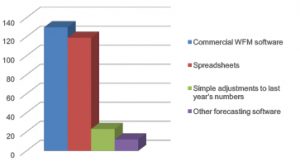
Choice of Forecast Model
Those who use a commercial WFM system were asked if they had a choice of forecasting models within the system. Approximately 40 percent indicated that they have only one option, while another 41 percent indicated they have several to choose from. However, almost 20 percent indicated that they did not know if there was more than one option in their system.
In many centers today, there are more work types than incoming calls. Some do skill-based routing, chat, email, outbound calling, and other options. Each of these has unique characteristics that suggest a forecasting model that uses appropriate assumptions will produce a more accurate result. Exploring the options with the vendor may reveal some ways to improve the accuracy for all the types of work performed.
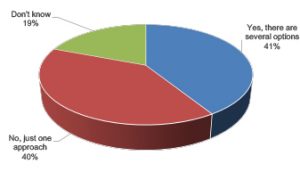
Understanding of the Forecasting Algorithm
Those who use a commercial WFM software were asked if they understood the mechanics of the forecasting algorithm used by their systems. Approximately one-third indicated that they have a full understanding of the math behind their algorithms, but just over half indicated that they have only a partial understanding. In 12 percent of the cases, the respondents indicated that they do not know how the math works in their systems.
Having a clear understanding of the algorithms used is needed to ensure that the right inputs are provided, and the interpretation of the outputs is accurate. Vendors should be asked to explain the math that is applied and how to use it to best advantage.
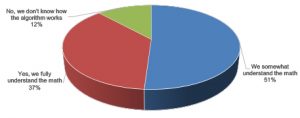
Drivers of Workload
Respondents were asked what the major drivers of the forecast are and could select all the options that applied. Each chose an average of four options and they are well spread out across the possibilities. Marketing affects the largest percentage, while billing cycles, weather, product releases, and mail drops were selected by about half each. A surprisingly large percentage indicated that call center system outages are a major driver of the forecast in their centers.
Understanding the potential drivers of both volume and handle time is critical to achieving an accurate forecast of the workload. Establishing a good working relationship with marketing is critical to achieving both maximum results for the marketing efforts as well as a more consistent service to customers.
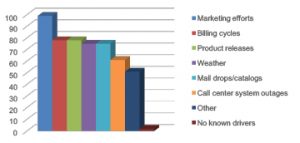
Frequency of New Forecasts
Respondents were asked how frequently they produce a new forecast. More than half (58%) indicated that they do it weekly while another 22 percent produce a new one monthly. Daily was the choice of 5 percent, 6 percent chose quarterly, 3 percent for twice a year, and another 3 percent only do a new one annually.
Those who are forecasting less frequently are generally those with fewer options to adjust schedules, fewer part-time personnel, and limited opportunities for adjustments to the staffing on an intraweek or intraday basis. Daily forecasting is helpful in adjusting to the intraday variations that can be more easily met with break optimizations and movement of off-phone periods such as meetings and non-call work. Weekly helps to adjust the start/end times within a narrow window of variation tolerable to the staff. Both more frequent forecasts can help to identify the need for overtime and the possibility of time off for the staff as well as adjustments needed to account for absences and reaction to short-term business drivers such as marketing campaigns and weather patterns.
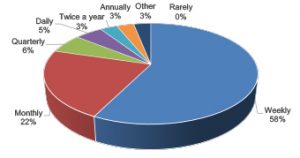
Forecasting Accuracy Measured
Respondents were asked if they measure the accuracy of the forecast against the actual results. Approximately two-thirds of the respondents measure accuracy at the daily level and at the monthly level. Approximately 30 percent measure at the interval level.
The purpose of checking the accuracy of the forecast is not only to measure performance of the WFM team, but to reveal opportunities to improve. It is difficult to know where the errors may be when only an overall accuracy is analyzed since there may be large variations in both directions offsetting each other within the average. Measuring at all these levels is useful, but interval level has the greatest potential to reveal a consistent anomaly that can be addressed in a revision to the forecast.
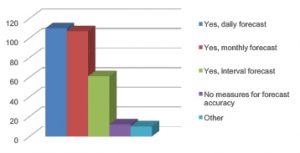
Biggest Challenges
Respondents were asked what they viewed as the biggest challenge to their forecasting processes. The answers tended to cluster around several repeated topics:
- Software is out of date or inaccurate, requiring manual adjustments.
- Outsourcers indicated that they struggle to get timely and accurate information from their clients to support the forecasting process.
Many find it difficult to get good communication from business partners (marketing, product development, sales, IT, etc.) that will let them know when a campaign or change is coming. - Weather patterns and unpredictability of their impacts were cited by several.
- Overall ongoing growth was mentioned as a factor.
- Small teams with low volumes were cited, as being just a few calls off can be a big percentage of error. This is particularly difficult in skill-based routing scenarios.
- Some lack reliable historical data which may be caused by new environments or poor control of the data that has been kept in the past.
Changes to the web site or movement of contacts between media can affect volumes and AHT unpredictably. - Inadequate staffing forces callers to abandon and call back, creating inaccurate arrival patterns for future forecasting.
- There is not a good understanding of the “sweet spot” between time spent on the process and the value of the increase in accuracy, from an organizational perspective.
- Volatility of AHT as well as volume makes it difficult to calculate accurate workload.
- Several cited outages as a major challenge including outside outages that cause contacts but also those outages to systems within the center.
- Constant business strategy and/or organizational changes invalidate historical data.
Closing Comments
Based on the responses above, forecasting is not used by many organizations as a tool to adjust staffing on an intraweek or intraday basis but is more focused on the longer term. Even though a new forecast may not be done frequently, the accuracy of the forecast vs. the actual results is analyzed by most on a daily or monthly basis. There seems to be a significant portion of the respondents relying on spreadsheets and other tools either to supplement the commercial WFM system or instead of it. The biggest challenges seem to be communications issues, either between the WFM team and internal customers (such as marketing, etc.) or between the center and its clients in the case of the outsourcers.
